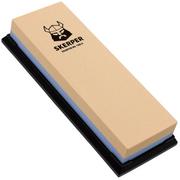How do you sharpen a chef's knife?
Sharpening your chef's knife? This may seem difficult, but it is not that bad. The principle is the same as with most other knives. Is the knife crushing rather than slicing a tomato? Then it's time to sharpen the knife.
Which sharpening method suits me?
The big question is: which sharpening method suits you best? There are several options. Consider a sharpening stone, a sharpening system, a sharpening steel, a pull-through sharpener, a rolling sharpener or an electric knife sharpener. Each method has its own pros and cons, and the choice depends mainly on how much time and effort you want to put into it.
To make it easy, we have listed everything for you, with clear videos that guide you step by step.

When to sharpen your chef's knife?
If your chef's knife crushes rather than slices a tomato, it's time for sharpening. A sharpening steel or strop can help between uses to straighten the edge and keep it sharp for a bit longer, but you won't prevent the need for sharpening altogether. How often you need to sharpen depends on how much you use your knife. With normal use, it is enough to sharpen your knife once or twice a year.
Sharpening a chef's knife? Here's how it works
How does sharpening work? Using the knife wears down the blade or may even dent the blade itself. Sharpening gives a new, sharp edge to the steel. You do this at a certain sharpening angle, usually around 20 degrees per side for European chef's knives. Japanese chef's knives are often sharpened at a smaller angle, usually around 15 degrees. The harder steel can take this well, meaning you can sharpen them to high levels of sharpness. That sharpness does have a downside: the edge is more susceptible to damage and requires a bit more careful use. Whatever angle you choose, it is important to keep that angle as even as possible during sharpening.
Sharpening a chef's knife on a sharpening stone
A sharpening stone is the most economical way to get your chef's knife sharp. By choosing the right grit size, you can really sharpen a knife to perfection. You always work from coarse to fine, so you usually need several stones. Unsure where to start? Read more about which grain size to start with here.
It takes some practice to master the technique, but with the right instruction (and a little patience), you can achieve a result you'll be proud of.
Sharpening a chef's knife with a pull-through sharpener
A pull-through sharpener is one of the easiest ways to get your chef's knife sharp again. A knife sharpener actually works quite simply: you pass the knife along a sharpening surface at a certain angle, grinding off a thin layer of steel from the blade. They are easy and work quickly, but the results are not the same as on a whetstone or sharpening system.
Sharpening a chef's knife with a sharpening system
Do you find it difficult to hold the sharpening angle yourself? Then a sharpening system is a godsend. The system fixes the knife or sharpening stone at a constant angle, so you always get great results. You need to worry less about technique. However, sharpening systems are often a bit pricier, which makes them especially interesting if you sharpen more often or want to keep several knives sharp.
Sharpening your chef's knife with a HORL rolling knife sharpener
A modern and very user-friendly option is the HORL knife sharpener. You place your knife against a magnetic holder that holds the right angle. Then you roll the sharpener along the edge and you're done. The system is not only practical, but also looks great on the countertop. A beautiful combination of simplicity and design.
Didn't find the information you were looking for? Check out all sharpening products here.













































?%24center=center&%24poi=poi&%24product-image%24=&fmt=auto&h=500&poi=%7B%24this.metadata.pointOfInterest.x%7D%2C%7B%24this.metadata.pointOfInterest.y%7D%2C%7B%24this.metadata.pointOfInterest.w%7D%2C%7B%24this.metadata.pointOfInterest.h%7D&scaleFit=%7B%28%24this.metadata.pointOfInterest%29%3F%24poi%3A%24center%7D&sm=c&w=1208)